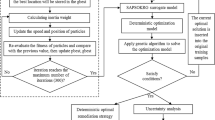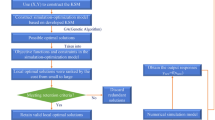Abstract
When the simulation-optimization model to optimize the groundwater extraction-treatment schemes is used, the construction of a surrogate model for the numerical simulation model has become an effective means to overcome the large calculation load of repeatedly calling the numerical model. However, there are still some problems in using the surrogate model, such as large training sample size, low accuracy, and poor optimization results. In this paper, a conservative adaptive Kriging surrogate model (CAKSM) was proposed by coupling the Kriging surrogate model, optimal solution adaptive sampling method (OSAS), and conservative prediction idea. Firstly, an initial Kriging surrogate model (IKSM) was built for the numerical simulation model of groundwater flow and solute transport. Then, the IKSM was coupled with the optimization model to construct the adaptive Kriging surrogate model (AKSM) by using OSAS. A safety margin was added to the AKSM to build the CAKSM. Finally, the simulation-optimization models based on IKSM, AKSM, and CAKSM were solved by the genetic algorithm, respectively. The results showed that the IKSM could well substitute for the simulation model. The AKSM significantly improved the approximation degree between the surrogate model and the simulation model at the optimal solution by supplementing a small number of new samples. CAKSM could effectively constrain the pollutant mass concentrations within the controlled value, improving the reliability of the optimization scheme. The optimal extraction wells based on different surrogate models were all well 5, well 6, and well 9. They were concentrated in the middle and lower reaches of the contaminated plume’s central axis. The sequence for the remediation effects by different surrogate models from high to low was as follows: CAKSM, AKSM, and IKSM. The risk rate of the optimal remediation scheme from the hydraulic conductivity random fields was as high as 12.12%, and the risks were mainly located upstream of the pollution plume’s central axis.








Similar content being viewed by others
Data availability
All data generated or analysed during this study are included in this article.
References
An Y, Lu W, Yan X (2018) A surrogate-based simulation-optimization approach application to parameters’ identification for the HydroGeoSphere model. Environ Earth Sci 77(17):621. https://doi.org/10.1007/s12665-018-7806-7
Chen Y, Wu J (2005) Effect of the spatial variability of hydraulic conductivity in aquifer on the numerical simulation of groundwater. Adv Water Sci 16(4):482–487. https://doi.org/10.14042/j.cnki.32.1309.2005.04.002
Chen R, Teng Y, Chen H, Hu B, Yue W (2019) Groundwater pollution and risk assessment based on source apportionment in a typical cold agricultural region in Northeastern China. Sci Total Environ 696:133972. https://doi.org/10.1016/j.scitotenv.2019.133972
Chen J, Dai Z, Yang Z, Pan Y, Zhang X, Wu J, Reza Soltanian M (2021) An improved tandem neural network architecture for inverse modeling of multicomponent reactive transport in porous media. Water Resour Res 57:e2021WR030595. https://doi.org/10.1029/2021WR030595
Cho SE (2014) Probabilistic stability analysis of rainfall-induced landslides considering spatial variability of permeability. Eng Geol 171(8):11–20. https://doi.org/10.1016/j.enggeo.2013.12.015
Compernolle T, Van Passel S, Lebbe L (2013) The value of groundwater modeling to support a pump and treat design. Groundwater Monitoring and Remediation 33(3):111–118. https://doi.org/10.1111/gwmr.12018
Davey KR (2008) Latin hypercube sampling and pattern search in magnetic field optimization problems. IEEE Trans Magn 44(6):974–977. https://doi.org/10.1109/TMAG.2007.916292
Freeze RA (1975) A stochastic-conceptual analysis of one-dimensional groundwater flow in nonuniform homogeneous media. Water Resour Res 11(5):725–741. https://doi.org/10.1029/wr011i005p00725
Fu X, Tang Z, Lv W, Wang X, Yan B (2018) Optimal pumpage to purify contaminative groundwater based on stochastic simulation. China Environ Sci 38(9):3421–3428. https://doi.org/10.19674/j.cnki.issn1000-6923.2018.0370
Govindaraju RS, Morbidelli R, Corradini C (2001) Areal infiltration modeling over soils with spatially correlated hydraulic conductivities. J Hydrol Eng 6:150–158. https://doi.org/10.1061/(ASCE)1084-0699(2001)6:2(150)
Gu L, Yang RJ, Tho CH, Makowski M, Faruque O, Li Y (2001) Optimization and robustness for crashworthiness of side impact. Int J Veh Des 26(4):348–360. https://doi.org/10.1504/IJVD.2001.005210
Hickernell FA (1998) A generalized discrepancy and quadrature error bound. Mathematics of Computation of the American Mathematical Society 67(221):299–322. https://doi.org/10.1090/S0025-5718-98-00894-1
Jourdan A, Franco J (2010) Optimal Latin hypercube designs for the Kullback-Leibler criterion. Asta-Advances in Statistical Analysis 94(4):341–351. https://doi.org/10.1007/s10182-010-0145-y
Kahn H (1950) Random sampling (Monte Carlo) techniques in neutron attenuation problems—I. Nucleonics 6(5):27
Kazemzadeh-Parsi MJ, Daneshmand F, Ahmadfard MA, Adamowski J (2015) Optimal remediation design of unconfined contaminated aquifers based on the finite element method and a modified firefly algorithm. Water Resour Manag 29(8):2895–2912. https://doi.org/10.1007/s11269-015-0976-0
Knill DL, Giunta AA, Baker CA, Grossman B, Mason WH, Haftka RT, Watson LT (1999) Response surface models combining linear and Euler aerodynamics for supersonic transport design. J Aircr 36(1):75–86. https://doi.org/10.2514/2.2415
Ko NY, Lee KK, Hyun Y (2005) Optimal groundwater remediation design of a pump and treat system considering clean-up time. Geosci J 9(1):23–31. https://doi.org/10.1007/BF02910551
Laloy E, Rogiers B, Vrugt JA, Mallants D, Jacques D (2013) Efficient posterior exploration of a high-dimensional groundwater model from two-stage Markov chain Monte Carlo simulation and polynomial chaos expansion. Water Resour Res 49(5):2664–2682. https://doi.org/10.1002/wrcr.20226
Leoni N, Amon CH (2000) Bayesian surrogates for integrating numerical, analytical, and experimental data: application to inverse heat transfer in wearable computers. IEEE Transactions on Components and Packaging Technologies 23(1):23–32. https://doi.org/10.1109/6144.833038
Li J, Chen Y, Pepper D (2003) Radial basis function method for 1-D and 2-D groundwater contaminant transport modeling. Comput Mech 32(1):10–15. https://doi.org/10.1007/S00466-003-0447-Y
Liu H (2016) The research and application of metamodel-based engineering optimization. Dalian University of Technology
Liu X, Chen Y, He R, Chen Y (2012) Application of Kriging surrogate model to optimization of earth observation satellite system. Acta Automat Sin 38(1):120–127. https://doi.org/10.3724/SP.J.1004.2012.00120
Lophaven S N, Nielsen H B, Sondergaard J (2002) Dace: A MATLAB Kriging toolbox. Kongens Lyngby: Technical University of Denmark, Technical Report No. IMM-TR-2002-12
Lu L, Wu J, Wang J (2008) Monte Carlo modeling of solute transport in a porous medium with multi-scale heterogeneity. Adv Water Sci 19(3):333–338. https://doi.org/10.14042/j.cnki.32.1309.2008.03.002
Luo J, Ji Y, Lu W (2019) Comparison of surrogate models based on different sampling methods for groundwater remediation. J Water Resour Plan Manag 145(5):04019015. https://doi.org/10.1061/(ASCE)WR.1943-5452.0001062
Matherton G (1963) Principles of geostatistics. Econ Geol 58:1246–1266. https://doi.org/10.2113/gsecongeo.58.8.1246
Mcphee J, Yeh WWG (2006) Experimental design for groundwater modeling and management. Water Resour Res 42(2):W02408. https://doi.org/10.1029/2005WR003997
Ouyang Q, Lu W, Miao T, Deng W, Jiang C, Luo J (2017) Application of ensemble surrogates and adaptive sequential sampling to optimal groundwater remediation design at DNAPLs-contaminated sites. J Contam Hydrol 207:31–38. https://doi.org/10.1016/j.jconhyd.2017.10.007
Picheny V, Kim NH, Haftka RT, Peters J (2006) Conservative estimation of probability of failure. 11th AIAA/ISSMO multidisciplinary analysis and optimization conference. https://doi.org/10.2514/6.2006-7038
Picheny V, Kim NH, Haftka RT (2008) Conservative estimations of reliability with limited sampling. ASME International Design Engineering Technical Conferences/Computers and Information in Engineering Conference, Las Vegas, NV, pp 1227–1236
Picheny V, Kim NH, Haftka RT, Queipo N (2013) Conservative predictions using surrogate modeling. 49th Aiaa/asme/asce/ahs/asc Structures, Structural Dynamics, & Materials Conference https://doi.org/10.2514/6.2008-1716.
Seaholm SK, Ackerman E, Wu SC (1988) Latin hypercube sampling and the sensitivity analysis of a Monte Carlo epidemic model. Int J Biomed Comput 23(1-2):97–112. https://doi.org/10.1016/0020-7101(88)90067-0
Sheng Y, Zhang X, Zhai X, Zhang F, Li G, Zhang D (2018) A mobile, modular and rapidly-acting treatment system for optimizing and improving the removal of non-aqueous phase liquids (NAPLs) in groundwater. J Hazard Mater 360:639–650. https://doi.org/10.1016/j.jhazmat.2018.08.044
Shi X, Wu J, Yuan Y (2005) Study on the spatial variability of hydraulic conductivity. Adv Water Sci 16(2):210–215. https://doi.org/10.14042/j.cnki.32.1329.2005.02.010
Taskinen A, Sirvio H, Bruen M (2008) Generation of two-dimensionally variable saturated hydraulic conductivity fields: model theory, verification and computer program. Comput Geosci 34(8):876–890. https://doi.org/10.1016/j.cageo.2007.04.010
Tatti F, Papini MP, Torretta V, Mancini G, Boni MR, Viotti P (2019) Experimental and numerical evaluation of groundwater circulation wells as a remediation technology for persistent, low permeability contaminant source zones. J Contam Hydrol 222:89–100. https://doi.org/10.1016/j.jconhyd.2019.03.001
Viana FAC, Picheny V, Haftka RT (2010) Using cross-validation to design conservative surrogates. AIAA J 48(10):2286–2298. https://doi.org/10.2514/1.J050327
Yang Y, Wu J, Luo Q, Zhang T, Wu J, Wang J (2017) Effects of stochastic simulations on multiobjective optimization of groundwater remediation design under uncertainty. J Hydrol Eng 22(8):1–12. https://doi.org/10.1061/(ASCE)HE.1943-5584.0001510
Yang Y, Ma Z, Jiang Y, Lian X, Xi B, Pei Y (2018) A nitrogen transformation model for multi-layer enhanced groundwater remediation technology. Environ Technol 39(22):2873–2881. https://doi.org/10.1080/09593330.2017.1369576
Zhang J (2017) Bayesian monitoring design and parameter inversion for groundwater contaminant source identification. Zhejiang University-Thesis Doctorate, Hangzhou
Zhang S, Liu H, Qiang J, Liu X, Zhu X (2019) Synchronous inversion of groundwater pollution source and aquifer parameters based on Bayesian formula. China Environ Sci 39(7):2902–2912. https://doi.org/10.19674/j.cnki.issn1000-6923.2019.0343
Zhang S, Qiang J, Liu H, Li Y (2020) Optimization design of groundwater pollution monitoring scheme and inverse identification of pollution source parameters using Bayes’ theorem. Water Air Soil Pollut 231(1):27. https://doi.org/10.1007/s11270-019-4369-5
Zheng X, Tang F, Jia J, Han J (2016) Development of a zero-valent iron-based in-site reactive zones technique for remediation of contaminated groundwater. Research of. Environ Sci 29(2):155–163. https://doi.org/10.13198/j.issn.1001-6929.2016.02.01
Acknowledgements
This study was supported by the Xuzhou University of Technology Research Project (Grant No. XKY2019119). Special gratitude is given to editors for their efforts in treating and evaluating the work, and the valuable comments of the anonymous reviewers are also greatly acknowledged.
Funding
Xuzhou University of Technology Research Project (Grant No. XKY2019119).
Author information
Authors and Affiliations
Contributions
All authors contributed to the study conception and design. Material preparation was performed by Shuangsheng Zhang. Data collection and analysis were performed by Jing Qiang and Shuangsheng Zhang. Software design and test were performed by Hanhu Liu, Xueqiang Zhu, and Hongli Lv. The first draft of the manuscript was written by Shuangsheng Zhang and Jing Qiang, and all authors commented on previous versions of the manuscript. All authors read and approved the final manuscript.
Corresponding author
Ethics declarations
Ethics approval
All authors kept the “Ethical Responsibilities of Authors”.
Consent to participate
All authors gave explicit consent to participate in this study.
Consent for publication
All authors gave explicit consent to publish this manuscript.
Conflict of interest
The authors declare no competing interests.
Additional information
Responsible Editor: Marcus Schulz
Publisher’s note
Springer Nature remains neutral with regard to jurisdictional claims in published maps and institutional affiliations.
Rights and permissions
About this article
Cite this article
Zhang, S., Qiang, J., Liu, H. et al. A construction strategy for conservative adaptive Kriging surrogate model with application in the optimal design of contaminated groundwater extraction-treatment. Environ Sci Pollut Res 29, 42792–42808 (2022). https://doi.org/10.1007/s11356-021-18216-5
Received:
Accepted:
Published:
Issue Date:
DOI: https://doi.org/10.1007/s11356-021-18216-5




